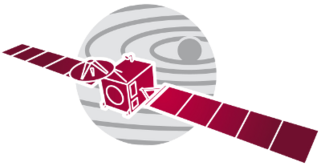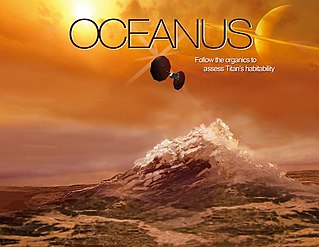Related Research Articles

Rosetta was a space probe built by the European Space Agency launched on 2 March 2004. Along with Philae, its lander module, Rosetta performed a detailed study of comet 67P/Churyumov–Gerasimenko (67P). During its journey to the comet, the spacecraft performed flybys of Earth, Mars, and the asteroids 21 Lutetia and 2867 Šteins. It was launched as the third cornerstone mission of the ESA's Horizon 2000 programme, after SOHO / Cluster and XMM-Newton.

Stardust was a 385-kilogram robotic space probe launched by NASA on 7 February 1999. Its primary mission was to collect dust samples from the coma of comet Wild 2, as well as samples of cosmic dust, and return them to Earth for analysis. It was the first sample return mission of its kind. En route to Comet Wild 2, it also flew by and studied the asteroid 5535 Annefrank. The primary mission was successfully completed on 15 January 2006 when the sample return capsule returned to Earth.

The Discovery Program is a series of Solar System exploration missions funded by the U.S. National Aeronautics and Space Administration (NASA) through its Planetary Missions Program Office. The cost of each mission is capped at a lower level than missions from NASA's New Frontiers or Flagship Programs. As a result, Discovery missions tend to be more focused on a specific scientific goal rather than serving a general purpose.

67P/Churyumov–Gerasimenko is a Jupiter-family comet. It is originally from the Kuiper belt and has a current orbital period of 6.45 years, a rotation period of approximately 12.4 hours, and a maximum velocity of 135,000 km/h. Churyumov–Gerasimenko is approximately 4.3 by 4.1 km at its longest and widest dimensions. It was first observed on photographic plates in 1969 by Soviet astronomers Klim Ivanovych Churyumov and Svetlana Ivanovna Gerasimenko, after whom it is named. It most recently came to perihelion on 2 November 2021, and will next come to perihelion on 9 April 2028.

The Comet Rendezvous Asteroid Flyby (CRAF) was a cancelled plan for a NASA-led exploratory mission designed by the Jet Propulsion Laboratory during the mid-to-late 1980s and early 1990s, that planned to send a spacecraft to encounter an asteroid, and then to rendezvous with a comet and fly alongside it for nearly three years. The project was eventually canceled when it went over budget; most of the money still left was redirected to its twin spacecraft, Cassini–Huygens, destined for Saturn, so it could survive Congressional budget cutbacks. Most of CRAF's scientific objectives were later accomplished by the smaller NASA spacecraft Stardust and Deep Impact, and by ESA's flagship Rosetta mission.

A sample-return mission is a spacecraft mission to collect and return samples from an extraterrestrial location to Earth for analysis. Sample-return missions may bring back merely atoms and molecules or a deposit of complex compounds such as loose material and rocks. These samples may be obtained in a number of ways, such as soil and rock excavation or a collector array used for capturing particles of solar wind or cometary debris. Nonetheless, concerns have been raised that the return of such samples to planet Earth may endanger Earth itself.

88P/Howell is a periodic comet with a 5.5 year orbital period. It was discovered on 29 August 1981, by Ellen Howell. In 1975 the comet's perihelion was 1.9 AU, but a close approach to Jupiter in 1978 perturbed the perihelion distance closer to the Sun. During the 2009 apparition the comet became as bright as apparent magnitude 8.
The New Frontiers program is a series of space exploration missions being conducted by NASA with the purpose of furthering the understanding of the Solar System. The program selects medium-class missions which can provide high science returns.
Marco Polo was a proposed space mission concept studied between 2005 and 2015 that would return a sample of material to Earth from the surface of a Near Earth asteroid (NEA) for detailed study in laboratories. It was first proposed to the European Space Agency in collaboration with the Japan aerospace exploration agency JAXA. The concept was rejected four times between 2007 and 2015 for the Cosmic Vision programme "M" medium-class missions.

101955 Bennu (provisional designation 1999 RQ36) is a carbonaceous asteroid in the Apollo group discovered by the LINEAR Project on 11 September 1999. It is a potentially hazardous object that is listed on the Sentry Risk Table and has the highest cumulative rating on the Palermo Technical Impact Hazard Scale. It has a cumulative 1-in-1,750 chance of impacting Earth between 2178 and 2290 with the greatest risk being on 24 September 2182. It is named after Bennu, the ancient Egyptian mythological bird associated with the Sun, creation, and rebirth.

The Planetary Science Decadal Survey is a serial publication of the United States National Research Council produced for NASA and other United States Government Agencies such as the National Science Foundation. The documents identify key questions facing planetary science and outlines recommendations for space and ground-based exploration ten years into the future. Missions to gather data to answer these big questions are described and prioritized, where appropriate. Similar decadal surveys cover astronomy and astrophysics, earth science, and heliophysics.

OSIRIS-REx was a NASA asteroid-study and sample-return mission that visited and collected samples from 101955 Bennu, a carbonaceous near-Earth asteroid. The material, returned in September 2023, is expected to enable scientists to learn more about the formation and evolution of the Solar System, its initial stages of planet formation, and the source of organic compounds that led to the formation of life on Earth. Following the completion of the primary OSIRIS-REx mission, the spacecraft is planned to conduct a flyby of asteroid 99942 Apophis, now as OSIRIS-APEX.
MoonRise is a robotic mission concept to the south pole of the Moon. It was proposed in 2017 for NASA's New Frontiers program mission 4, but it was not selected. If funded and launched by another NASA opportunity, it would focus on the giant South Pole–Aitken basin on the far side of the Moon between the Moon's South Pole and Aitken Crater, 16° south of the Moon's equator. This basin measures nearly 2,500 kilometres (1,600 mi) in diameter and 12 kilometres (7.5 mi) in depth. This region is the oldest and deepest observable impact basin on the Moon and provides a window into the deep crust of the Moon and its history as a result. The basin is also among the largest recognized impact structures in the Solar System.

Oceanus is a NASA/JPL orbiter mission concept proposed in 2017 for the New Frontiers mission #4, but it was not selected for development. If selected at some future opportunity, Oceanus would travel to Saturn's moon Titan to assess its habitability. Studying Titan would help understand the early Earth and exoplanets which orbit other stars. The mission is named after Oceanus, the Greek god of oceans.

Comet Nucleus Dust and Organics Return (CONDOR) is a mission concept to retrieve a sample from comet 67P/Churyumov–Gerasimenko to test ideas regarding Solar System formation, and accretion of rocky planets with habitable surface environments.

CAESAR is a sample-return mission concept to comet 67P/Churyumov–Gerasimenko. The mission was proposed in 2017 to NASA's New Frontiers program mission 4, and on 20 December 2017 it was one of two finalists selected for further concept development. On 27 June 2019, the other finalist, the Dragonfly mission, was chosen instead.
Castalia is a proposed mission concept for a robotic spacecraft to explore the main-belt comet 7968 Elst–Pizarro and make the first in situ measurements of water in the asteroid belt, and thus, help solve the mystery of the origin of Earth's water. The lead is Colin Snodgrass, from The Open University in UK.
Tianwen-2 is a planned Chinese asteroid sample return and comet exploration mission that is currently under development. Tianwen-2 was originally known as ZhengHe.
Chimera is a NASA mission concept to orbit and explore 29P/Schwassmann-Wachmann 1 (SW1), an active, outbursting small icy body in the outer Solar System. The concept was developed in response to the 2019 NASA call for potential missions in the Discovery-class, and it would have been the first spacecraft encounter with a Centaur and the first orbital exploration of a small body in the outer Solar System. The Chimera proposal was ranked in the first tier of submissions, but was not selected for further development for the programmatic reason of maintaining scientific balance.
References
- ↑ "海外ミッションを利用した太陽系サンプルリターン探査" (PDF) (in Japanese). Advisory Committee for Space Engineering. Archived from the original (PDF) on 2019-10-13. Retrieved 2019-10-13.
- 1 2 3 4 CORSAIR (COmet Rendezvous, Sample Acquisition, Investigation, and Return): A New Frontiers Mission Concept to Collect Samples from a Comet and Return them to Earth for Study (PDF). S. A. Sandford, N. L. Chabot, N. Dello Russo, J. C. Leary, E. L. Reynolds, H. A. Weaver, D. H. Wooden. 80th Annual Meeting of the Meteoritical Society 2017 (LPI Contrib. No. 1987).
- ↑ "Proposed New Frontiers Missions". Future Planetary Exploration. 4 August 2017. Archived from the original on 20 September 2017. Retrieved 2017-09-20.
- ↑ Triangular Rollable And Collapsible Boom (TRACTM Boom), NASA SBIR 2016 Solicitation, Proposal Nbr. 16-2 Z4.01-7700.





